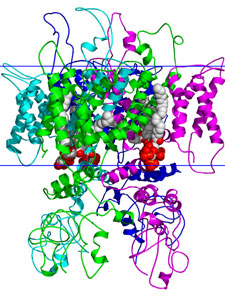A new discovery demonstrates that acupuncture needle stimulation translates into neurological signaling with the help of a special protein receptor.  TRPV1The new research helps to explain how physical stimulation of an acupuncture point with a needle activates powerful biochemical responses relating to human health. Western blotting, immunoflourescence and other scientific procedures reveal that a special protein receptor, gene and cation channel are involved in the effective actions and signaling pathways of needling acupuncture point ST36 (Zusanli).
TRPV1The new research helps to explain how physical stimulation of an acupuncture point with a needle activates powerful biochemical responses relating to human health. Western blotting, immunoflourescence and other scientific procedures reveal that a special protein receptor, gene and cation channel are involved in the effective actions and signaling pathways of needling acupuncture point ST36 (Zusanli).
TRPV1, a transient receptor potential cation channel, is a gene and related receptor that forms a mechano-sensitive ion channel. The receptor is activated by changes in temperature and other forms of mechanical stimulation. TRPV1 is “highly expressed at ST36” according to the new research. Calcium wave propagation (CWP) components were also highly expressed in the TRPV1 related tissues at ST36.
Acupuncture continuing education and research into the mechanisms by which acupuncture exerts its medicinal effects is advanced with this new finding. The research demonstrates that CWP is activated during acupuncture. The results of the investigation “suggest TRPV1 might act as acupuncture-responding channel by sensing physical stimulation from acupuncture and conducting the signaling via CWP to nerve terminals.”
 The researchers note that the investigation provides important insight into the methods by which physical stimulation from acupuncture needles activates neurological signaling.
The researchers note that the investigation provides important insight into the methods by which physical stimulation from acupuncture needles activates neurological signaling.
Reference:
Wu, Shu-Yih, Wei-Hsin Chen, Ching-Liang Hsieh, and Yi-Wen Lin. "Abundant expression and functional participation of TRPV1 at Zunsanli acupoint (ST36) in mice: mechanosensitive TRPV1 as an." BMC complementary and alternative medicine 14, no. 1 (2014): 96.
Author Affiliations: China Medical University, Taichung, Taiwan.


